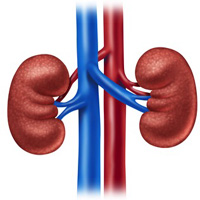The active guidewire technique versus standard technique as different way to approach ureteral endoscopic stone treatment

Accepted: August 25, 2021
All claims expressed in this article are solely those of the authors and do not necessarily represent those of their affiliated organizations, or those of the publisher, the editors and the reviewers. Any product that may be evaluated in this article or claim that may be made by its manufacturer is not guaranteed or endorsed by the publisher.
Background: One of the greatest challenges in semi-rigid ureteroscopies, for both stones and tumors, is the control of endoscopic vision and the maintenance of low intracavitary liquid pressure. We present a comparison between two operative techniques: in the first method an ordinary guide wire (diameter 0.032'') is used for the procedure; in the second one a 5 Fr ureteral catheter replaces the guidewire (we called it “Active guidewire”)
Methods We compared 50 semirigid ureteroscopies (sURS) performed using the active guidewire with another 50 procedures conducted with a classic guidewire. We evaluated the difference in operating times, quality of endoscopic vision, periprocedural infections rate and stone-free rate.
Results: The use of active guidewire has considerably reduced the standardized operating times per unit stone-volume by about 39%. Vision quality has improved considerably thanks to the continuous flow in-and-out. Consequently, periprocedural infections decreased (3% vs 30%) and the stone-free rate rose from 86% to 92%.
Discussion and conclusions: Employing an “active guidewire” instead of the standard guidewire, the risk of complications related to high pressures and operating time is considerably lower, as well as better treatment quality thanks to the cleaner vision. This technique has proven to be safe as well as easy to apply, and in our belief is to be preferred whenever the ureter accepts without forcing, both the presence of the catheter and the semi-rigid 7 F ureteroscope.
Michel MS, Honeck P, Alken P. Conventional high pressure versus newly developed continuous-flow ureterorenoscope: urodynamic pressure evaluation of the renal pelvis and flow capacity. J Endourol. 2008; 22:1083-1085. DOI: https://doi.org/10.1089/end.2008.0016
Ma YC, Jian ZY, Yuan C, et al. Risk factors of infectious complications after ureteroscopy: a systematic review and meta-analysis based on adjusted effect estimate, Surg Infect. 2020; 21:811-822. DOI: https://doi.org/10.1089/sur.2020.013
Southern JB, Higgins AM, Young AJ, et al. Risk Factors for postoperative fever and systemic inflammatory response syndrome after ureteroscopy for stone disease. J Endourol. 2019; 33:516-522. DOI: https://doi.org/10.1089/end.2018.0789
Fulla J, Prasanchaimontri P, Rizk A, Loftus C, et al. Ureteral diameter as predictor of ureteral injury during ureteral access sheath placement. J Urol. 2021; 205:159-164. DOI: https://doi.org/10.1097/JU.0000000000001299
Li T, Sun XZ, Lai DH, et al. Fever and systemic inflammatory response syndrome after retrograde intrarenal surgery: Risk factors and predictive model. Kaohsiung. J Med Sci. 2018; 34:400-408. DOI: https://doi.org/10.1016/j.kjms.2018.01.002
Moses RA, Ghali FM, Pais VM, Jr, Hyams E. Unplanned hospital return for infection following ureteroscopy - Can we identify modifiable risk factors? J Urol. 2016; 195:931-936. DOI: https://doi.org/10.1016/j.juro.2015.09.074
Mitsuzuka K, Nakano O, Takahashi N, Satoh M. Identification of factors associted with postoperative febrile urinary tract infection after ureteroscopy for urinary stones. Urolithiasis. 2016; 44:257-262. DOI: https://doi.org/10.1007/s00240-015-0816-y
Blackmur JP, Maitra NU, Marri RR, et al. Analysis of factors association with risk of postoperative urosepsis in patients undergoing ureteroscopy for treatment of stone disease. J Endourol. 2016;30:963-969. DOI: https://doi.org/10.1089/end.2016.0300
Boulalas I, De Dominicis M, Defidio L. Semirigid ureteroscopy prior retrograde intrarenal surgery (RIRS) helps to select the right ureteral access sheath. Arch Ital Urol Androl. 2018; 90:20-24. DOI: https://doi.org/10.4081/aiua.2018.1.20
Ogreden E, Oguz U, Demirelli E, et al. Categorization of ureterooscopy complications and investigation of associated factors by using the modified Clavine classification system. Turk J Med Sci. 2016; 46:686-694. DOI: https://doi.org/10.3906/sag-1503-9
Somani BK, Giusti G, Sun Y, et al. Complications associated with ureterorenoscopy (URS) related to treatment of urolithiasis: the clinical research Office of Endourological Society URS Global study. World J Urol. 2017; 166:538-540. DOI: https://doi.org/10.1007/s00345-016-1909-0
Proietti S, Dragos L, Somani BK, Buttice S, Talso M, Emliani E, et al. In vitro comparision of maximum pressure developed by irrigation systems in a kidney model. J Endourol. 2017;31:522-527 DOI: https://doi.org/10.1089/end.2017.0005
De Coninck V, Keller EX, Somani B, et al. Complications of ureteroscopy: a complete overview. World J Urol. 2020; 38:2147-2166. DOI: https://doi.org/10.1007/s00345-019-03012-1
Bai J, Li C, Wang S, et al. Subcapsular renal haematoma after holmium: yttrium-aluminium-garnet laser ureterolithotripsy. BJU Int. 2012; 109:1230-1234. DOI: https://doi.org/10.1111/j.1464-410X.2011.10490.x
Hyams ES, Munver R, Bird VG, et al. Flexible ureterorenoscopy and holmium laser lithotripsy for the management of renal stone burdens that measure 2 to 3 cm: a multi-institutional experience J Endourol. 2010; 24:1583-1588. DOI: https://doi.org/10.1089/end.2009.0629
Xu L, LiG Life-threatening subcapsular renal hematoma after flexible ureteroscopic laser lithotripsy: treatment with superselective renal arterial embolization. Urolithiasis. 2013; 41:449-451. DOI: https://doi.org/10.1007/s00240-013-0585-4
Meng HZ, Chen SW, Chen GM, et al. Renal subcapsular Hemorrhage complicating ureterolithotripsy: an unknown complication of a know day-to-day procedure. Urol Int. 2013; 91:335-339. DOI: https://doi.org/10.1159/000350891
PAGEPress has chosen to apply the Creative Commons Attribution NonCommercial 4.0 International License (CC BY-NC 4.0) to all manuscripts to be published.


 https://doi.org/10.4081/aiua.2021.4.431
https://doi.org/10.4081/aiua.2021.4.431



